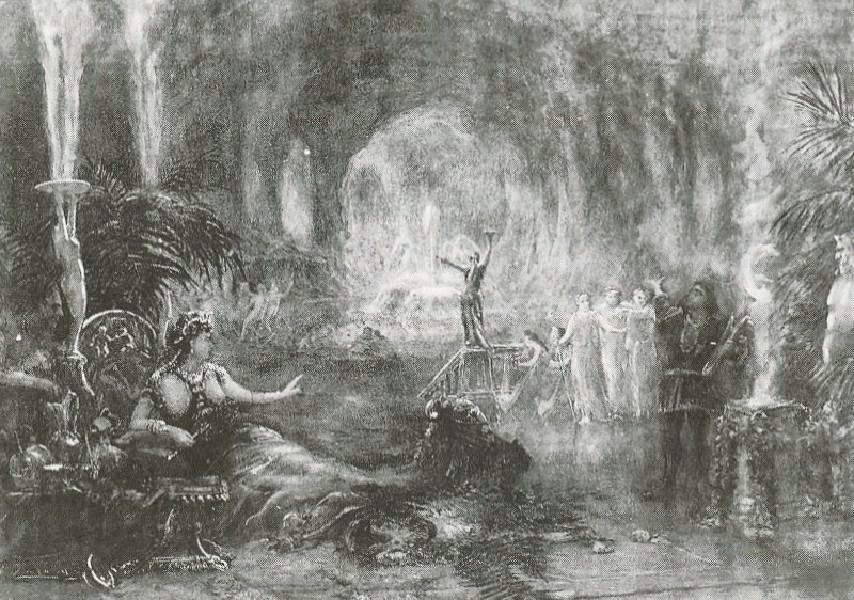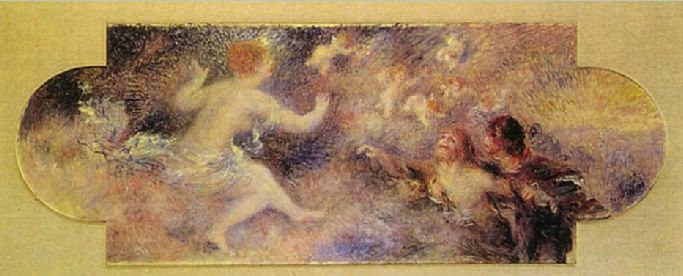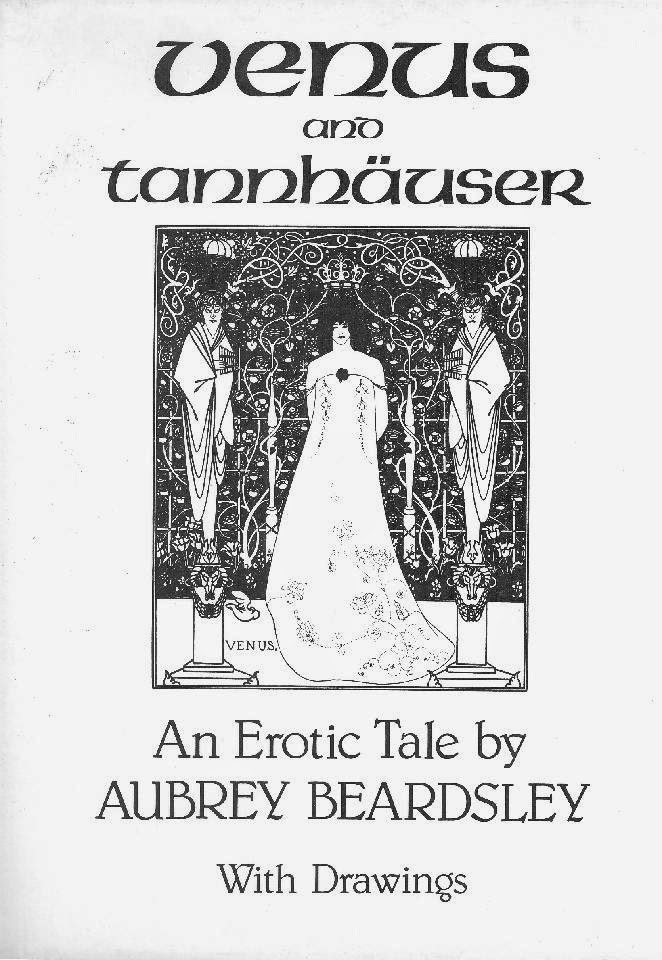Tweet
The ancient Roman mural painting (height: 92 cm width: 242 cm), c.10 BC - 10 AD, was discovered in 1605 on the Esquiline Hill in Rome and soon transferred to a villa on the Quirinal Hill, possession of the Aldobrandini family, hence its name (2). Since 1818 in the Biblioteca Apostolica Vaticana in Rome. It has been restored several times.
In literature there is fair agreement about the personages depicted.
The central figures on the bed represent the bare-breasted Aphrodite, Goddess of love, who informs the veiled bride.
On the right of the bed sits on the ground the youth Hymen, deity of marriage (3), and further to the right, three Muses are preparing for the festivity.
On the left, leaning against a pillar stands the half-naked Peitho, deity of persuasion, a classical attendant of Aphrodite (4). Further to the left: servants for the wedding.
But who is the bride? - art historians formulated several hypotheses, but like in the case of TIZIANO's painting "...I prefer to leavethe merit to the curious ones."(5). Anyhow, the composition of the central figures is reminiscent of a marble relief showing 'Aphrodite persuading Helen to go with Paris' where also Peitho is present (6).
Around the same time Pietro da CORTONA BERRETTINI (1596-1669) also made a drawing, printed in 1627 by Bernardino CAPITELLI (1590-1637). The print was the first of a whole series of book illustrationsfrom the 17th onwards (7).
A copy painting, credited to Nicolas POUSSIN (1594-1665) by the original owners, the dal Pozzo family, is now in the Galleria Doria-Pamphilj, Rome. Many other artists, visiting or residing in Rome, made identical copies.
There is, however, a painting by Antonio ZUCCHI (1726-1795), owned by English Heritage, with a totally different composition, though of comparable format and entitled 'The Aldobrandini Marriage '.
A 2000-year old wall decoration frieze known as the 'Aldobrandini Wedding (Nozze Aldobrandini)' is another type of 'allegory of marriage', even more intriguing than the painting by TIZIANO (1). Its popularity among artists of the 17th-19th centuries is the subject of this post.
The ancient Roman mural painting (height: 92 cm width: 242 cm), c.10 BC - 10 AD, was discovered in 1605 on the Esquiline Hill in Rome and soon transferred to a villa on the Quirinal Hill, possession of the Aldobrandini family, hence its name (2). Since 1818 in the Biblioteca Apostolica Vaticana in Rome. It has been restored several times.
In literature there is fair agreement about the personages depicted.
| Aphrodite and the bride |
The central figures on the bed represent the bare-breasted Aphrodite, Goddess of love, who informs the veiled bride.
| Hymen |
On the right of the bed sits on the ground the youth Hymen, deity of marriage (3), and further to the right, three Muses are preparing for the festivity.
| Peitho |
But who is the bride? - art historians formulated several hypotheses, but like in the case of TIZIANO's painting "...I prefer to leavethe merit to the curious ones."(5). Anyhow, the composition of the central figures is reminiscent of a marble relief showing 'Aphrodite persuading Helen to go with Paris' where also Peitho is present (6).
 |
| Marble relief in Museo Archeologico Nazionale, Napoli |
About the repetitions
 |
| VAN DYCK's sketch |
Antoon VAN DYCK (1599-1641) was one of the first attracted to the fresco:
"Si vede nel gierdino di Aldobrandino / dipinto in fresco anticho"
a drawing in the sketchbook of his Italian journey (1623-27), owned by the British Museum.
 |
| CORTONA's drawing |
Around the same time Pietro da CORTONA BERRETTINI (1596-1669) also made a drawing, printed in 1627 by Bernardino CAPITELLI (1590-1637). The print was the first of a whole series of book illustrationsfrom the 17th onwards (7).
 |
| paintingafter POUSSIN ? |
 |
| ZUCCHI's painting |
An Italian fan depicting 'The Aldobrandini Wedding', created c1780, was a present for Queen Mary, consort of George V, King of the United Kingdom (1867-1953) (8).
Details, including references to the owners, of many repetitions are presented in myHistro 'story' with interactive timeline (click on 'Play' or any name in the horizontal time graph)
Details, including references to the owners, of many repetitions are presented in myHistro 'story' with interactive timeline (click on 'Play' or any name in the horizontal time graph)
| The Aldobrandini Wedding - A 2000-year old fresco |
You can also get for free a myHistro.com application for iPhone/iPod touch with simplified functionality: combining maps, timelines, photos, videos and blogging.
Notes
(1) See post of September 8, 2014 "Déjà-vu (3): repetitions of TIZIANO's 'Allegory of marriage'"
and September 29, 2014: "Déjà-vu (4): variants of TIZIANO's 'Allegory of marriage' and comparison with other masterworks"
(2) For full scholarly references, see Census of Antique Works of Art and Architecture Known in the Renaissance: CensusID 10007607
See also Wikipedia or about the past and the present of the Aldobrandini family.
(3) In Greek mythology, Hymen (Ancient Greek: Ὑμήν), Hymenaios or Hymenaeus was a god of marriage ceremonies, who attended every wedding.
(4)
Unlike the other attendants of Aphrodite - the Three Graces, immensely popular in Western art - Peitho is seldom depicted, though she is well-known in ancient artworks.
(5) There are numerous scholarly publications about these hypotheses.
According to'Harpers Dictionary of Classical Antiquities' (edited by H.T. Peck, Harper and Brothers, New York 1898), p.566, the decoration wall is a copy of an original by the distinguished Greek painter Echion who flourished about 352 BC.
(6) The marble relief (67 x 66 cm) is in the Museo Archeologico Nazionale in Naples. The names in Greek are scarved in the marble: left behind Aphrodite and Elena sits on a platform Peitho, right is Eros with Alexandros (Paris). It is a copy from the first century BC of a Hellenistic relief from the 2nd century BC. Reference for the illustration: E. M. Moormann & W. Uitterhoeve 'Van Achilleus tot Zeus'. SUN, Nijmegen 1988, p.113; for the role of Peitho: S. IJsseling 'Apollo, Dionysos, Aphrodite en de anderen - Griekse goden in de hedendaagse filosofie' Boom , Amsterdam 1994, pp.128-130.
(7) There are countless book illustrations since many books on Greek-Roman culture discuss the 'Aldobrandini Wedding'.
See also Wikipedia or about the past and the present of the Aldobrandini family.
(3) In Greek mythology, Hymen (Ancient Greek: Ὑμήν), Hymenaios or Hymenaeus was a god of marriage ceremonies, who attended every wedding.
(4)
| Peitho (left) taking Eros to Venus and Anteros |
(5) There are numerous scholarly publications about these hypotheses.
According to'Harpers Dictionary of Classical Antiquities' (edited by H.T. Peck, Harper and Brothers, New York 1898), p.566, the decoration wall is a copy of an original by the distinguished Greek painter Echion who flourished about 352 BC.
(6) The marble relief (67 x 66 cm) is in the Museo Archeologico Nazionale in Naples. The names in Greek are scarved in the marble: left behind Aphrodite and Elena sits on a platform Peitho, right is Eros with Alexandros (Paris). It is a copy from the first century BC of a Hellenistic relief from the 2nd century BC. Reference for the illustration: E. M. Moormann & W. Uitterhoeve 'Van Achilleus tot Zeus'. SUN, Nijmegen 1988, p.113; for the role of Peitho: S. IJsseling 'Apollo, Dionysos, Aphrodite en de anderen - Griekse goden in de hedendaagse filosofie' Boom , Amsterdam 1994, pp.128-130.
(7) There are countless book illustrations since many books on Greek-Roman culture discuss the 'Aldobrandini Wedding'.
(8) Other art objects:
* a shellcameorepresentingthe'Aldobrandini Wedding"', late eighteenthcentury, wornby Mrs.Eynard-Lullinat the Congress of Vienna (Ville de Genève, Collections d'art et d'histoire, comptes rendus pour l'année 1905, p.26);
* Manufactures Sèvres: vase representing 'Les Noces Aldobrandines', 1800-1802, 90x49 cm, Compiègne, Palais impérial, inv [1894A] C. 267c.

























































































































